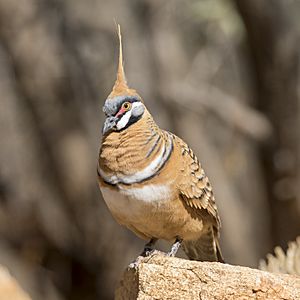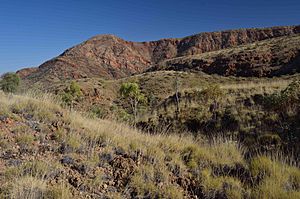Spinifex pigeon facts for kids
Quick facts for kids Spinifex pigeon |
|
|---|---|
 |
|
| Conservation status | |
| Scientific classification | |
| Genus: |
Geophaps
|
| Species: |
plumifera
|
The spinifex pigeon (Geophaps plumifera) is a small bird found only in Australia. It's also called the plumed-pigeon. This bird is part of a group known as bronzewing pigeons. The International Union for Conservation of Nature (IUCN) says it's a species "of least concern," meaning it's not currently in danger. You'll often find these pigeons in dry and semi-dry areas. They like places with special grasses called Triodia and Plectrachne, which are often called 'spinifex grasses'.
Contents
About the Spinifex Pigeon
John Gould first described the spinifex pigeon in 1842. Since then, scientists have studied it a lot. They looked at many birds from different places to figure out the different types.
There are three main types, or subspecies, of spinifex pigeons:
- Eastern spinifex pigeon (Geophaps plumifera leucogaster) - This one has a white belly and lives in central-eastern Australia.
- North-western spinifex pigeon (Geophaps plumifera plumifera) - This type also has a white belly and lives in north-western Australia.
- Pilbara spinifex pigeon (Geophaps plumifera ferruginea) - This one has a brown belly and lives in the Pilbara region of Western Australia.
These different types likely formed because of changes in the climate long ago. When Australia became drier, groups of pigeons got separated. This led to them developing slightly different features.
What They Look Like
The spinifex pigeon is a small, round bird. It weighs about 80 to 110 grams and is about 20 to 23.5 centimeters long. Its wings can spread out to 30 to 35 centimeters. Male birds are a little bigger than females, but it's hard to tell them apart just by looking.
Their feathers are a reddish-brown color. They have thin black stripes on their wings and back. Their forehead and the sides of their head are grey. They have a black beak. Their face has bright, clear markings. There's a bright red area around their eyes, with black lines above and below it. A white band goes from their chin to behind their eye, and their throat is black. They also have a white stripe on their chest. Their legs and feet are grey. Their feathers look the same all year round.
The color of their belly can be different depending on where they live. This is why the western birds with brown bellies are a separate subspecies.
Where They Live
Spinifex pigeons live in many dry and semi-dry parts of northern and central Australia. They prefer rocky hills, mountains, gorges, and dry creek beds. They live in places that can get extremely hot during the day and very cold at night. These areas also have big changes in rainfall and can have long droughts.
You'll most often find them where 'spinifex grasses' grow. These grasses can cover large areas or grow under scattered trees like Desert Oak, Eucalypts, and Mulga. Even though they are called "spinifex pigeons," they sometimes prefer other types of sparse grasslands.
They usually avoid cities, but they can live in natural areas near people. They need to be close to water sources, usually within a few kilometers. They use both natural waterholes and man-made water troughs.
How They Behave
Spinifex pigeons like to stay in one place and live in groups. They usually stay within a few kilometers of a permanent water source. You'll often see them in pairs or small groups of 4 to 20 birds. Sometimes, though, a very large group of up to 400 birds has been seen!
They often gather around water sources to drink. They do this mostly in the mid-morning and around noon, when it's hottest. Larger groups form when conditions are good, like after rain. When food or water is scarce, they spread out. These groups seem to have regular areas they live in. They travel together to find food and water.
Sometimes, these pigeons do a special bowing dance. They spread their tail like a fan and raise their folded wings. Their eye pupils get smaller. This display shows off shiny patches on their feathers and their black outer tail feathers. This dance isn't always for other birds; it can just be a way for them to show confidence.
They also have a head-shaking display. This seems to be a greeting between pairs or a warning to other birds. The bird crouches down, lowers its head, flattens its crest, and shakes its beak and head forward.
Reproduction
Spinifex pigeons can breed all year round. However, they breed most often in spring and summer. This is when there's more rain and more food available.
They mate on the ground. The female scratches a shallow nest in the stony ground and lines it with grass. Other nesting pairs might be nearby. The female lays two cream-colored eggs. Both the male and female take turns sitting on the eggs for 16 to 18 days. Young birds are ready to be on their own after about four to six weeks.
Large numbers of pigeons can gather, but their numbers go down during long droughts. After it rains and food becomes plentiful, their numbers slowly recover as they breed locally.
What They Eat
Spinifex pigeons are special because they live in dry spinifex habitats and don't move far. They can handle tough conditions. The amount of drought-resistant seeds they can find changes a lot with the seasons. During long droughts, food can become very scarce.
They look for food on the ground, either alone, in pairs, or in small groups. They mostly eat seeds, plant material, and insects. They often search in bare areas between grass clumps. Sometimes they look in dry creek beds or along the edges of dry wetlands.
Their diet is almost entirely made up of seeds from grasses and herbs that can survive droughts. Surprisingly, spinifex grass itself isn't a major food source for them. They eat very small amounts of animals and other plant material. They might also eat food given by humans, especially near camping areas.
They usually look for food early in the morning and late in the afternoon. These are the cooler parts of the day, and they stay close to water sources.
Staying Safe from Predators
Spinifex pigeons are not strong long-distance fliers. They are better at short, quick flights up or across. This helps them escape predators in places like steep hills and gorges. When you approach them, they are often quite brave. They might stay still until you get very close.
They mostly stay on the ground. To escape predators, they rely on running and their reddish-brown feathers. Their feathers help them blend in with the desert sand and rocks. They will often run away instead of flying when someone gets close.
At the nest, adult birds have been seen defending their young in captivity. In the wild, they might even leave their eggs or hatchlings as a distraction for predators.
Their Calls
The spinifex pigeon has many different calls. These include calls to attract a mate, display calls, calls to stay in touch with others, alarm calls, and warning calls. Generally, their calls range from a soft, high-pitched "coo" or "cooloo-coo" to a deep "coo-r-r-r."
How They Survive in the Desert
Spinifex pigeons live in very harsh desert environments. They have to deal with extreme heat and little water. Their home range includes some of the hottest places on Earth. For example, Marble Bar in Western Australia can have temperatures over 37.8°C for up to 160 days a year!
They get water by drinking and by making it inside their bodies. They don't get much water from their food. It's very important for them to stay hydrated. This is because they use evaporative cooling (like sweating) to keep cool when it's hot. That's why they usually live close to permanent water sources.
These pigeons can handle high temperatures because their bodies produce less heat. They can also let their body temperature rise a bit, which helps them lose heat. They also lose a fair amount of water through evaporation to stay cool.
Threats and Conservation
Some early reports suggested that when sheep farms replaced horse farms, it reduced good habitats for these pigeons. However, other experts think that the spinifex pigeon's range might have actually grown since Europeans settled in Australia. This is because more permanent watering holes were built for livestock in areas that didn't have surface water before.
Today, the main threats to spinifex pigeons probably include too much grazing by farm animals and wild animals. Also, uncontrolled bushfires and climate change, which leads to higher temperatures and less water, are concerns.
Currently, the spinifex pigeon is listed as a species of "least concern" by the IUCN. This means it's not considered endangered right now. Its habitats are protected in several national parks. These include Tjoritja/West MacDonnell National Park, Watarrka National Park, Purnululu National Park, Kakadu National Park, and Diamantina Lakes National Park.
Similar Birds
The crested pigeon and the gannaway pigeon look a bit like the spinifex pigeon. The spinifex pigeon is the only other Australian pigeon with an upright crest on its head. However, you can easily tell the spinifex pigeon apart. It's smaller, has rusty-colored feathers, clear facial markings, and lives in desert habitats.
Images for kids
See also
 In Spanish: Paloma plumífera para niños
In Spanish: Paloma plumífera para niños





